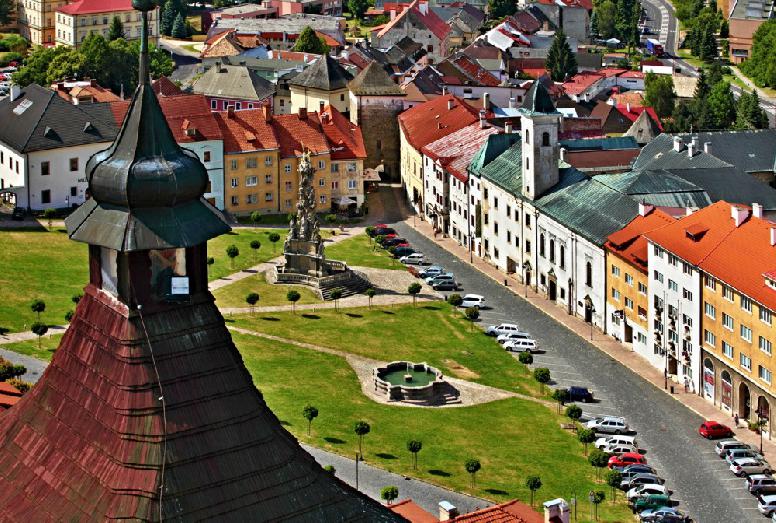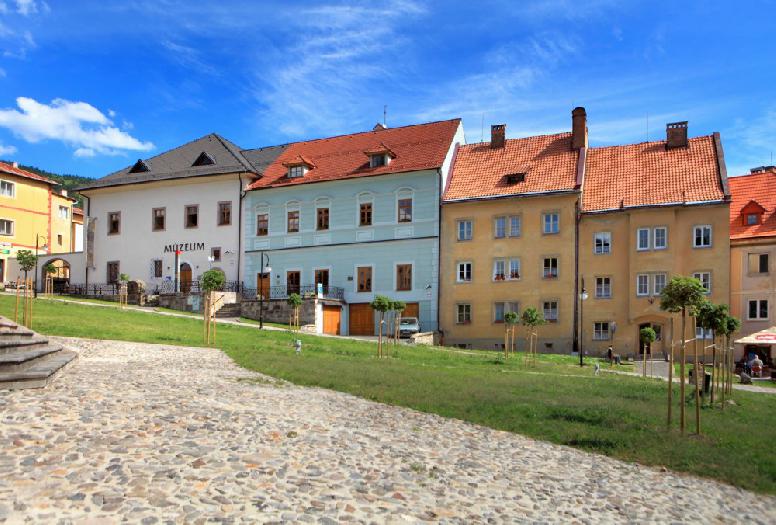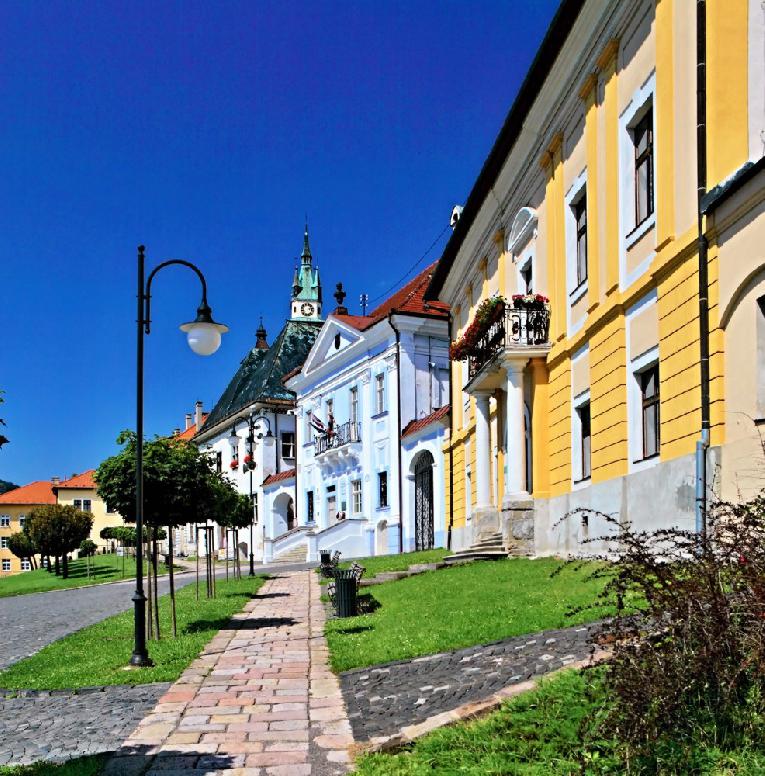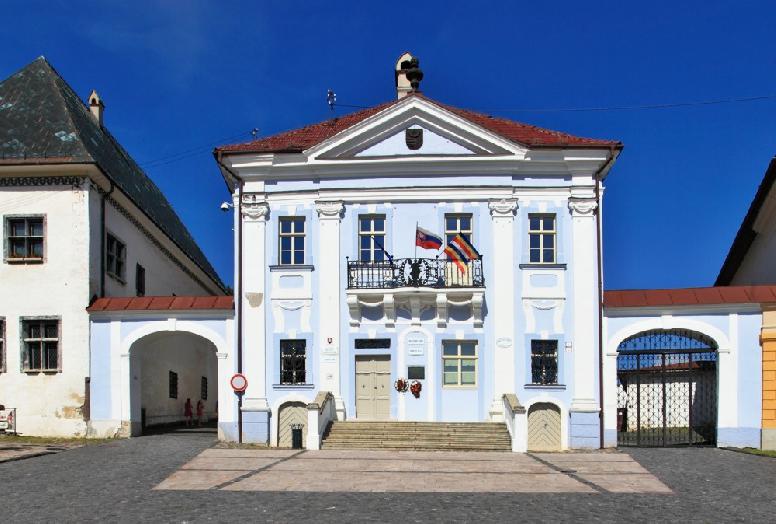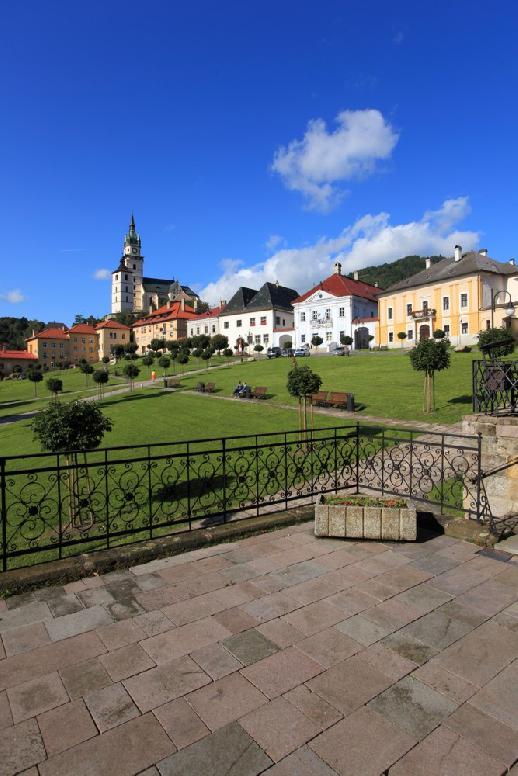House No. 1/1 - Town Hall
Until the fire in 1560 the town hall was located in the town castle and in time it moved to several houses on the square. The building of today's town hall originated in the second half of the 14th century by joining the two burgher hall houses. The town bought it in 1738 for the purposes of the town hall and rebuilt it in late-baroque style with elements of classicism. Above the medieval halls of the ground floor and basement a new boardroom was created. Front facade is decorated with central balcony on the massive consoles, with the statue of Justice on the forged bars. The representative building is supplemented by the wide axially oriented stairs. Two wings basement divided by the wall can be accessed by the pompous late gothic portals. The only passageway between them is located in the rear part with the stone spiral staircase with gothic portal is preserved. Rear parts of the town hall is a good example of a sensitive restoration of the monuments. The foundation of the originally standalone object near the Bystricka gate is the disposition of the gothic burgher house with depth oriented entry hall. There is a hall with a gothic oriel on the floor. Today's late gothic facade is reconstructed and restored in the 20th century in the spirit of the supposed traditions. In the exterior there are the original late gothic forms of plasters with ornaments, luxury windows, oriel, smoke and air holes. In the interior there are medieval sedilia and precious ribbed vaults. The town bought the house in 1880 for the town hall and for the purposes of the town archive.
House No. 3/5
Behind the Empire facade from the 18th century there is the late gothic two wing burgher house hidden, one of the first stone houses on the square. Two spacial basement is accessible by the gothic spindle staircase inserted into the walls where the perimeter walls meet. The town parish resides In the house with the baroque-made interior from 1877. Probably in that time they placed the stone statues of St. Rozalia and St. Christopher on the sides of the staircase made by the creators of the Trinity column.
House No. 4/7
belongs among the best preserved late gothic palatial patrician burgher houses. The passage to the yard is arched by the legendary diamond vault. In the left wing , behind the staircase there is chamber, the importance of which is stressed by the small crossing bars in the lintel with preserved gothic forged door wings, curtains and lock. Renovated facades with original portal and right-angled windows with central stone crosses are emphasized with late gothic forms of plasters. In the rear part there is a ground object with large late gothic windows.
Houses No. 10/19 a 11/21
were parts of the original gothic terraced housing of the southern wing. While in the upper part of the square the free plots of land with standalone burgher houses, closeness of the buildings in the southern part represents a specific solution in the medieval Kremnica. It was determined by the need for the mutual support of the individual buildings in the steep terrain. Two wings two floors house No. 10/19 with basement is dominated by the deep hall - mázhaus. There is the reconstructed gothic furnace in the upper floor above mázhaus. Until 1652 the house served as parish, later, until 1758 there was a town hall. Today the National Bank of Slovakia owns the object, where it set up the numismatic exposition of the Museum of Medals and Coins. Present floor plan of the house
No. 11/21 (administrative building of MMM) is a result of the medieval building development (picture: detail of the ornamented inscription belt from 1484). In the interior the renaissance elements were preserved - forged banister and door with intarsia. Living room 3 of the upper floor is lit by the monumental 4 parts cross window. By the end of the 19th century a pharmacy was in the front part of the western wing. In early 20th century they changed the facade and added a terrace to the part of the front facade. "Gazdík's dedičná" pharmacy, already state owned, remained in operation until 1992. The room with early baroque coffered ceiling (above right) and the original furniture of the pharmacy was completely reconstructed.
House No. 34/42
in the wester part of the square is one of the most opulent burgher gothic houses in the medieval space. Richly formed arch in the form of an ass back is attached to the wide panelling of the main portal. It comprises of the round and pear bars between the deep grooves. 3 parts window, originally illuminating the entrance hall has the similar profile. On the staircase there is the original portal, gothic details were preserved on the facades in the yard. The style shows the imported origin from the times around mid 15th century.
House No. 33/40
with the medieval core received in time the later baroque palace character. Facade is dominated by the entrance bevelled semi-circular column portal with the side right-angled windows, bearing oriel and statues of Salvator and Immaculata. On the floor there is a so called "green room", vaulted by the barrel vault (p. 82). Here the restorers uncovered painted decoration. The room got its name usual in Central Europe thanks to the green ornaments. The wall painting consists of the two basic dated layers and mimics the coffered ceiling with vegetable ornaments. The painting from 1525 was enriched in 1527 by a small architectural motifs with a ledge, pilasters and dolphins. Later the whole ceiling was painted (coffering remained preserved) and in the fields the renaissance rosettes were inserted. The original painting was made in the renaissance style, though its contents was late gothic. Lunette vaults, facade from, Tuscan columns and flat plastering framing come from the 17th century.
House No. 32/38
doesn't belong among the typical Kremnica burgher buildings. Its width was limited by the space between the two already standing houses. Unusually narrow building grew high. It's one wing object creating mázhaus in all its floor plan with flat ceiling, on higher floors there are the hall dispositions. In the front facade there's a traditional entry to the cellar. The house belonged to the Freyseyssen family until the 19th century. In 1622 it was enriched with the vault with the rich stucco decoration - arch abutment with diamond or heart cut with a bunch of grapes. The house with the stone leaf jamb, late renaissance forged balusters and wooden inlaid cabinet represents the late renaissance burgher architecture.
House No. 14/2 - Bello´s house
is the first reconstructed late gothic burgher house in Kremnica. The scheme of the building comes from the traditional 3 section house. According to the complex of the late gothic shaped elements it is possible to set the date around 1500. In the interior there are precious late gothic portals. In the basement, accessible via gothic portal from the street, there are late gothic cylinder column with diamond head supporting the vault. In the exterior in the niche of the side facade there is late gothic wall painting preserved depicting crowned Virgin Mary with the scene of Jesus's birth (left). In renaissance they often supplemented the interior with lunette vaults. Part of the interior was was changed by adding the wide staircase. On the house there is a memorial plaque of the composer Ján Levoslav Bello, who lived here in the years 1869-91.
Dom č. 542/3 - House with diamond vault
Large multi-storey object with late gothic entrance portal in southern part of the floor emerged thanks to the annexes to the older house. Renovated late gothic part is dated to 1488 by a mask console with devil on the southern facade, which is related to the figurines on the vault of the presbytery of the castle church. On the facades and in the interior other gothic stone portals, various opening and two and three part windows were preserved. Around 1520 the diamond vault was added, thus giving the house its name. Rooms with diamond vaults are separated by the late gothic saddle portal. Western wing served as the farm building and was built together with the passage in the street section. This abode is today also known as the house of Peter Michalica, a place of the festival Music under the diamond vault.


 Slovensky
Slovensky Deutsch
Deutsch